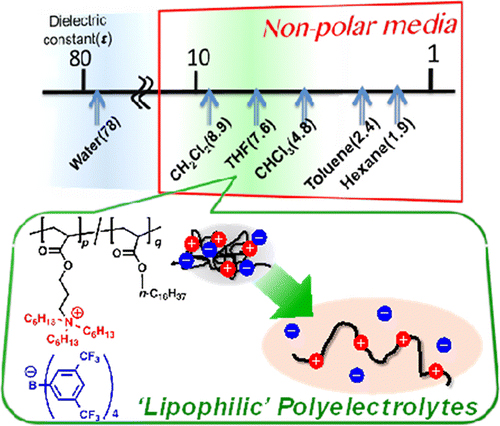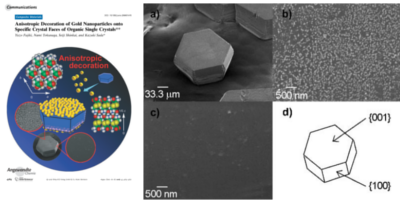Research
Breakthrough Materials Created by Manipulation of Molecular Information
Is a "mixture" always bothering us? Mixture is a combination of two or more different compounds, and sometimes expresses a negative meaning due to the impurity from viewpoints of classical organic chemistry. Until now, many chemists have devoted themselves to how to purify a compound from a mixture, or synthesize and analyze a pure compound.
Contrary to this trend, we aspire for a breakthrough on functions, structures, and reactions, which are achieved by elaborately mixed various components, i.e., "emergence". The ultimate purpose of our research is to understand new phenomena and develop novel functional materials by mixing compounds!!
In this context, we have endeavored to control association and dissociation among compounds in order to construct hierarchal architectures in a wide range of scale from nano to millimeter by mixing multiple components, in which an ordered communication of components and/or energies spontaneously occurs.
As a culmination of mixtures, we hope to create a cell, the basic structural and functional unit of all known living organisms. The components of cell are enclosed in a micron-scale container separated by cell membrane, and create so-called "living state". Continuous evolution for 4 billion years has produced such a sophisticated and astonishing mixture having abundant functions and information. Our quest for “what is life” will focus on that kind of a complex chemistry by devoting our best knowledge on organic chemistry, polymer chemistry, physical chemistry, non-equilibrium thermal dynamics, and so on.
- 1) Development of new soft materials utilizing lipophilic electrolyte
- 2) Post functionalization of metal-organic framework (MOF) via click chemistry
- 3) Development of hybrid material based on anisotropic regularity of organic crystals
- 4) Construction of motility device driven by ATP
1)Development of new soft materials utilizing lipophilic electrolyte
Before now, all researches on polyelectrolyte have focused on their functions in highly polar solvents such as water. Therefore, no polyelectrolyte applied in nonpolar organic solvents (ε<10) has been reported, because common polyelectrolytes collapse in such solvents owing to the formation of a higher order of aggregates of ions and ion pairs.
We conceived that the introduction of ionic groups dissociating even in low-dielectric media (ε<10), i.e., ion pair consisting of lipophilic and bulky substituents, allows us to create novel "lipophilic polyelectrolyte" acting as polyelectrolyte in such media.
- ACS Macro Letters 2012, 1(11), 1270-1273. link
Following this concept, we discovered a reasonable molecular design of lipophilic polyelectrolyte gels acting as superabsorbent polymers by cross-linking the "lipophilic polyelectrolyte". The resulting gel exhibited a high degree of swelling more than 100 times as much as their dried weights in less-polar and nonpolar organic solvents. These results will be one of the most promising methodologies to achieve unprecedented materials that can absorb volatile organic compound (VOC) or raw petroleum, which are applicable as an oil fence.
We revealed that our lipophilic polyelectrolyte gels showed discontinuous volume changes in non-polar organic solvent mixtures, which can be useful for the construction of stimuli-sensitive materials in media other than water.
- Soft Matter 2008, 4, 748-750. (Hot Article) link
2) Post functionalization of metal-organic framework (MOF) via click chemistry
Metal-organic frameworks (MOFs) consists of organic ligands as frames and metal ions as nodes have become one of the most fascinating porous materials because of their ability of gas storage, catalysts, and sensors. The robust frameworks allow us to design the sizes and shapes of the nano-sized pores by proper selection of the organic ligands and metal ions. We have accomplished synthesis of a metal−organic framework bearing azide groups in the organic ligands and in situ click reactions with various alkynes. By using this method, we can obtain MOFs having fragile or flexible substituents in their pore, which are not suitable for the crystallizing condition to prepare MOFs.
- J. Am. Chem. Soc. 2008, 130, 14354-14355. link
3) Development of hybrid material based on anisotropic regularity of organic crystals
Since the concept of crystal engineering was proposed, there have been a plenty of reports on single crystal of organic molecules having designed structure, property, reactivity, and function derived from their crystal structures. Anisotropicity or face-selective morphology is known to be most notable characteristics of organic single crystals, thus many researchers have suggested their potential possibility as functional materials. In our laboratory, two prominent concepts, i.e., crystal engineering and supramolecular chemistry, have been combined with each other in order to construct novel self-assembled structures attained by elaborate design of regularity of organic crystals and intermolecular interactions in them.
4) Construction of motility device driven by ATP
Have you ever wondered how you do all the things you do everyday? Well, there are actually lots and lots of high-performance molecular machines working together inside in your cells that give you the power to brush your teeth, talk to friends and do all the things you need to do each day. These are called 「Biomolecular Motors」The fuel for these biomolecular motors is known as ‘adenosine-5’-triphosphate’ (ATP) which is the same fuel that gives energy to all living things. Using this fuel, biomolecular motors can provide a huge amount of energy (10KW/Kg (Science 2000, 288, 95.)), almost 100 times larger than that of widely used electric motors.
Modern technology is still far away from producing such a powerful molecular machine. By making the best use of this valuable gift from nature, our group is aiming to design an artificial robot where biomolecular motors will be working as the central power generating unit.
Although biomolecular motors are able to work alone, their performance is amplified many times when they work together. For example, in muscles the biomolecular motors join together with other complementary proteins to form a ‘system’. One such system is named ‘actin-myosin’. Inside a muscle cell many actin-myosin systems assemble together into a highly organized structure called ‘sarcomere’. As the sarcomeres in different cells join together they generate dynamic motion. This is how biomolecular motors can ensure the complex but smooth movement of the living body in various daily activities. Such dynamic motion could not be achieved by a single biomolecular motor.
Our group is aiming to understand and replicate this and other emergent functions (i.e., functions that only become possible when biomolecular motors assemble) of biomolecular motor systems. Therefore it is crucial for us to understand how biomolecular motors assemble together. By doing this, our group hopes to contribute to the understanding of the various emergent functions observed in nature.
- J. Am. Chem. Soc. 2009, 131, 18089.
- Adv. Mater. 2002, 14, 1124.
This content requires the Adobe Flash Player.







